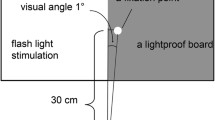Summary
Steady-state visual evoked magnetic fields (SSVEFs) were recorded in response to a flickering light source using a 37-channel magnetometer. The SSVEF had a sinusoidal waveform having the same fundamental frequency as the driving stimulus, which was either 6.0 Hz, 11.9 Hz, or 15.2 Hz. SSVEF topographies at each frequency had a dipoloar form over the posterior head that could well-modelled by single equivalent current dipoles. The best-fit dipoles were localized in posterior occipital cortex for the SSVEFs to 6.0 and 11.9 Hz stimuli and in more anterior and ventromedial occipital cortex for the 15.2 Hz SSVEP.
Similar content being viewed by others
References
Elbert, T., Pantev, C., Wienbruch, C., Rockstroh, B. and Taub, E. Increased cortical representation of the fingers of the left hand in string players. Science, 1995, 270: 305–307.
Morgan, S.T., Hansen, J.C. and Hillyard, S.A. Selective attention to stimulus location modulates the steady-state visual evoked potential. Proceedings of the National Academy of Sciences, 1996, 93: 4770–4774.
Regan, D. Human Brain Electrophysiology: Evoked Potentials and Evoked Magnetic Fields in Science and Medicine. Elsevier Pubs., New York, 1989.
Sarvas, J. Basic mathematical and electromagnetic concepts of biomagnetic inverse problem. Physics in Medicine and Biology, 1987, 32: 11–22.
Silberstein, R.B. Steady-state visually evoked potentials, brain resonances, and cognitive processes. In: P.L. Nunez (Ed.), Neocortical Dynamics and Human EEG Rhythms. Oxford, Univ. Press, Oxford, 1995: 272–303.
Silberstein, R.B., Schier, M.A., Pipingas, A., Ciorciari, J., Wood, S.R. and Simpson, D.G. Steady-state visually evoked potential topography associated with a visual vigilance task. Brain Topography, 1990, 3: 337–347.
Tobimatsu, S., Tomoda, H. and Kato, M. Normal variability of the amplitude and phase of steady-state VEPs. Electroencephalography and Clinical Neurophysiology, 1996, 100: 171–176.
Williamson, S.J. and Kaufman, L. Theory of neuroelectric and neuromagnetic fields. In: F. Grandori, M. Hoke and G.L. Romani (Eds.), Auditory Evoked Magnetic Fields and Electric Potentials. Karger, Basel, 1990.
Wilson, G.F. and O'Donnell, R.D. Steady-state evoked responses: Correlations with human cognition, Psychophysiology, 1986, 23: 57–61.
Author information
Authors and Affiliations
Corresponding author
Additional information
This work was supported by grants from the Deutsche Forschungsgemeinschaft, the U.S. Office of Naval Research (N00014-93-1-0942) and N.I.M.H. (MH-25594). The authors thank Lacey Kurelowech, Parti Quint, Joslyne Foley and Annette Sterr for their help in data recording and technical assistance. We also thank Matt Marlow for software assistance and Prof. Thomas Elbert for helpful comments on data analysis.
Rights and permissions
About this article
Cite this article
Müller, M.M., Teder, W. & Hillyard, S.A. Magnetoencephalographic recording of steadystate visual evoked cortical activity. Brain Topogr 9, 163–168 (1997). https://doi.org/10.1007/BF01190385
Accepted:
Issue Date:
DOI: https://doi.org/10.1007/BF01190385




